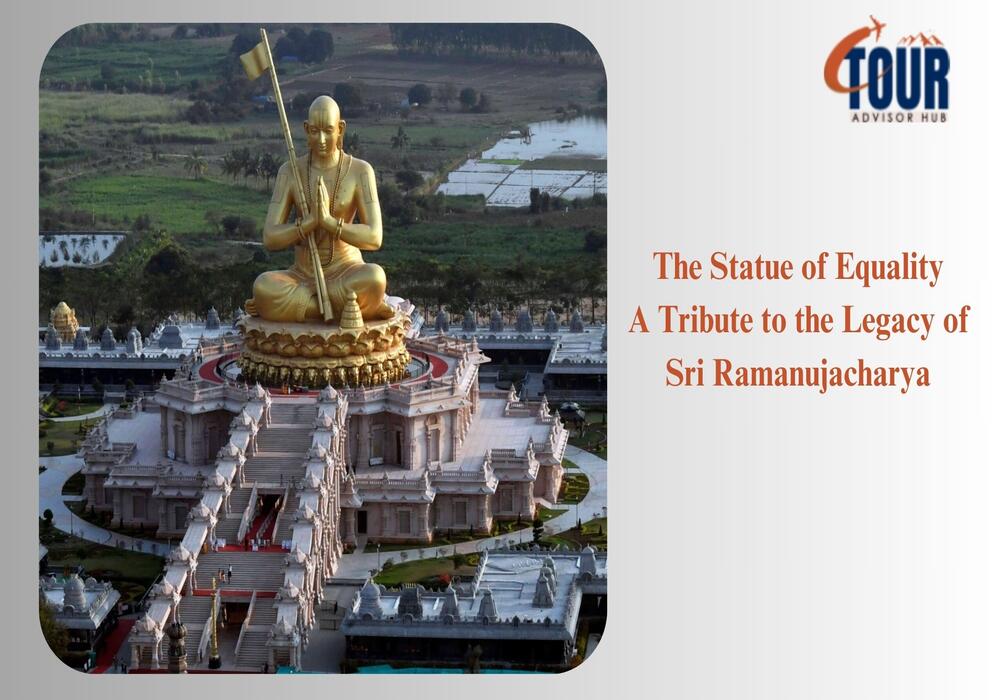The Statue of Equality, located in Hyderabad, India, is a monumental tribute to the 11th-century philosopher and social reformer Sri Ramanujacharya. Renowned for his teachings on equality and universal brotherhood, Sri Ramanujacharya’s legacy resonates deeply in Indian culture, and this grand structure immortalizes his contributions to humanity.
This blog delves into the details of the Statue of Equality, its historical and cultural significance, architectural marvels, and what visitors can expect at this awe-inspiring site.
Who Was Sri Ramanujacharya?
Sri Ramanujacharya, born in 1017 CE in Tamil Nadu, was a profound philosopher, theologian, and social reformer. He is best known for:
- Advaita Vedanta Interpretation: His philosophical work on Vishishtadvaita Vedanta emphasized qualified non-dualism, which focuses on the unity of God with the diversity of creation.
- Social Equality: Ramanujacharya pioneered inclusivity, advocating that spiritual wisdom and rituals should be accessible to all, regardless of caste, creed, or gender.
- Bhakti Movement Influence: His teachings inspired the Bhakti movement, emphasizing devotion as a path to liberation.
Ramanujacharya’s principles of equality, love, and compassion are deeply relevant even today, making the creation of the Statue of Equality a significant cultural endeavor.
Overview of the Statue of Equality
The Statue of Equality, known as Ramanuja Swamy Statue, is one of the tallest metallic statues in the world. It was inaugurated on February 5, 2022, to commemorate Sri Ramanujacharya’s 1,000th birth anniversary. The project was spearheaded by Chinna Jeeyar Swamiji, a prominent spiritual leader.
Key Facts About the Statue
- Height: 216 feet (including the base)
- Material: Panchaloha (a sacred alloy of five metals: gold, silver, copper, brass, and zinc)
- Location: Samshabad, Hyderabad, Telangana, India
- Cost: Approximately ₹1,000 crores
- Inauguration: The statue was unveiled by Indian Prime Minister Narendra Modi.
Architectural Marvel
The Statue of Equality is a blend of traditional Indian design and modern engineering, making it an architectural masterpiece.
1. Main Statue
- The main statue of Ramanujacharya is seated in a meditative posture, symbolizing peace, wisdom, and equality.
- The statue is crafted using Panchaloha, symbolizing strength, divinity, and resilience.
2. Base Structure (Bhadra Vedi)
- The statue is elevated on a 54-foot base, known as Bhadra Vedi.
- The base houses a museum and exhibition halls, showcasing the life and teachings of Ramanujacharya.
- A digital library offers scriptures, books, and multimedia content on Indian philosophy and spirituality.
3. 108 Divya Desams
- Surrounding the statue are replicas of 108 Divya Desams, the holy shrines of Lord Vishnu mentioned in Tamil literature.
- These miniature temples highlight the sacred significance of Ramanujacharya’s devotion to Vishnu and his role in preserving these shrines.
4. Meditation Hall
- The Meditation Hall, located within the complex, offers a serene space for visitors to reflect and meditate.
Significance of the Statue of Equality
The Statue of Equality serves multiple purposes:
- Spiritual Significance: It celebrates the teachings of Ramanujacharya, promoting equality, compassion, and devotion.
- Cultural Heritage: The structure honors India’s rich cultural and philosophical heritage.
- Tourism and Education: The site has become a prominent tourist destination and an educational center for spiritual seekers.
- Message of Unity: The statue emphasizes the importance of inclusivity and the eradication of discrimination in society.
Visitor Experience at the Statue of Equality
Visiting the Statue of Equality is a mesmerizing experience. Here’s what you can expect:
1. Entrance and Surroundings
The entrance features beautiful gardens and water fountains that create a tranquil ambiance. Visitors are greeted with stunning views of the colossal statue from a distance.
2. Exhibition and Museum
- Exhibition Halls: Interactive displays and audiovisual presentations narrate the life story of Sri Ramanujacharya.
- Artifacts: Historical and spiritual artifacts related to Indian philosophy and culture are showcased.
3. The 108 Divya Desams
Walking through the 108 miniature temples is a spiritual journey in itself. Each shrine is intricately designed, offering a glimpse into the sacred architecture of India.
4. Laser Show
In the evening, a laser and light show illuminates the statue, narrating Ramanujacharya’s life and teachings in a visually captivating manner.
5. Cultural Events
The complex often hosts cultural programs, including classical music, dance, and Vedic chanting, further enriching the visitor experience.
How to Reach the Statue of Equality
Location:
- The Statue of Equality is located in Muchintal, near Shamshabad, about 30 kilometers from Hyderabad city center.
By Air:
- The nearest airport is Rajiv Gandhi International Airport, Shamshabad, which is approximately 10 kilometers away.
By Train:
- The nearest railway station is Hyderabad Deccan Railway Station (Nampally), about 30 kilometers from the site.
By Road:
- The site is easily accessible by road, with well-connected highways and local transport options.
If you’re visiting the statue, here are some nearby attractions you can explore:
1. Sri Lakshmi Narasimha Swamy Temple, Yadagirigutta (Approx. 70 km)
A famous pilgrimage site dedicated to Lord Narasimha, known for its divine ambiance and scenic hilltop location.
2. Ramoji Film City (Approx. 40 km)
One of the world’s largest film studio complexes, offering film sets, adventure parks, live shows, and entertainment for all age groups.
3. Charminar (Approx. 30 km)
Hyderabad’s iconic monument is surrounded by bustling markets selling pearls, bangles, and delicious street food.
4. Golconda Fort (Approx. 35 km)
A historic fort known for its acoustic architecture, spectacular views, and evening light-and-sound show.
5. Salar Jung Museum (Approx. 30 km)
One of India’s largest museums, showcasing rare artifacts, sculptures, and an impressive clock gallery.
6. Hussain Sagar Lake & Buddha Statue (Approx. 35 km)
A scenic lake with a massive Buddha statue at its center, perfect for boating and sunset views.
7. Chowmahalla Palace (Approx. 30 km)
A stunning Nizam-era palace featuring intricate architecture, vintage cars, and royal collections.
8. Nehru Zoological Park (Approx. 35 km)
A great place for wildlife enthusiasts, with safari rides, reptile houses, and a vast variety of animals.
9. Wonderla Amusement Park (Approx. 45 km)
A thrilling water and adventure park ideal for families and adrenaline seekers.
10. Shilparamam (Approx. 40 km)
An arts and crafts village in Hitech City, offering traditional handicrafts, cultural performances, and shopping.
Future Prospects
The Statue of Equality is envisioned to inspire generations by promoting values of social harmony, inclusion, and spiritual wisdom. It also plays a crucial role in promoting Hyderabad as a global tourism hub, attracting visitors from across the world.
Conclusion
The Statue of Equality stands as a timeless symbol of Sri Ramanujacharya’s vision of an inclusive society where everyone is treated equally. Its grandeur, spiritual significance, and cultural richness make it a must-visit destination for those seeking inspiration, knowledge, and serenity.
Whether you are a spiritual seeker, a history enthusiast, or a traveler looking for unique experiences, the Statue of Equality offers a journey into India’s philosophical and cultural legacy. Plan your visit to this iconic monument and be part of a movement that celebrates equality and universal brotherhood.



